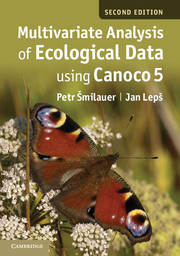Book contents
- Frontmatter
- Contents
- Preface
- 1 Introduction and data types
- 2 Using Canoco 5
- 3 Experimental design
- 4 Basics of gradient analysis
- 5 Permutation tests and variation partitioning
- 6 Similarity measures and distance-based methods
- 7 Classification methods
- 8 Regression methods
- 9 Interpreting community composition with functional traits
- 10 Advanced use of ordination
- 11 Visualising multivariate data
- 12 Case study 1: Variation in forest bird assemblages
- 13 Case study 2: Search for community composition patterns and their environmental correlates: vegetation of spring meadows
- 14 Case study 3: Separating the effects of explanatory variables
- 15 Case study 4: Evaluation of experiments in randomised complete blocks
- 16 Case study 5: Analysis of repeated observations of species composition from a factorial experiment
- 17 Case study 6: Hierarchical analysis of crayfish community variation
- 18 Case study 7: Analysis of taxonomic data with discriminant analysis and distance-based ordination
- 19 Case study 8: Separating effects of space and environment on oribatid community with PCNM
- 20 Case study 9: Performing linear regression with redundancy analysis
- Appendix A Glossary
- Appendix B Sample data sets and projects
- Appendix C Access to Canoco and overview of other software
- Appendix D Working with R
- References
- Index to useful tasks in Canoco 5
- Subject index
10 - Advanced use of ordination
Published online by Cambridge University Press: 05 May 2014
- Frontmatter
- Contents
- Preface
- 1 Introduction and data types
- 2 Using Canoco 5
- 3 Experimental design
- 4 Basics of gradient analysis
- 5 Permutation tests and variation partitioning
- 6 Similarity measures and distance-based methods
- 7 Classification methods
- 8 Regression methods
- 9 Interpreting community composition with functional traits
- 10 Advanced use of ordination
- 11 Visualising multivariate data
- 12 Case study 1: Variation in forest bird assemblages
- 13 Case study 2: Search for community composition patterns and their environmental correlates: vegetation of spring meadows
- 14 Case study 3: Separating the effects of explanatory variables
- 15 Case study 4: Evaluation of experiments in randomised complete blocks
- 16 Case study 5: Analysis of repeated observations of species composition from a factorial experiment
- 17 Case study 6: Hierarchical analysis of crayfish community variation
- 18 Case study 7: Analysis of taxonomic data with discriminant analysis and distance-based ordination
- 19 Case study 8: Separating effects of space and environment on oribatid community with PCNM
- 20 Case study 9: Performing linear regression with redundancy analysis
- Appendix A Glossary
- Appendix B Sample data sets and projects
- Appendix C Access to Canoco and overview of other software
- Appendix D Working with R
- References
- Index to useful tasks in Canoco 5
- Subject index
Summary
This chapter introduces six more advanced techniques, which build on the foundations of constrained ordination methods and can be used with the Canoco software. Principal response curves (PRC) (Section 10.1, illustrated in Section 16.6) are useful when comparing the development of biotic communities in time under different conditions. Principal coordinates of neighbour matrices (PCNM, also known as dbMEM) technique (Section 10.2, illustrated in Chapter 19) allows us to study the spatial structure present in data and compare it with (separate it from) the effects of environment or experimental manipulation. Linear discriminant analysis (LDA, also known as CVA) is a traditional method of taxonomical studies, but it can be also useful in the field of population or community biology (Section 10.3, illustrated in Section 18.3). Section 10.4 demonstrates the hierarchical decomposition of community composition variation and Chapter 17 presents a case study using this method. Decomposition of the total biotic diversity into its alpha- and beta-diversity components using ordination methods is explained in Section 10.5 and illustrated with a practical example in Section 12.4. Finally, Section 10.6 briefly summarises how the community composition can be predicted for a given combination of environmental conditions.
Principal response curves (PRC)
When we experimentally manipulate whole communities, we often evaluate the effect of the experimental treatments over a longer period, because the response to disturbance or to nutrient addition has a strong temporal aspect. When we need to compare the community composition at sites differing in experimental treatment with the control (unmodified) sites at different sampling times, it is quite difficult to do so using an ordination diagram from a standard constrained ordination. The temporal trajectory of each site is usually not a straight line going through the ordination diagram, but rather a complex, wiggling path (see Figure 16–8 for an example). It is therefore difficult to evaluate the extent of differences among the individual time steps and – more importantly – among the individual treatments, across the time. Van den Brink and Ter Braak (1998, 1999) developed a new method called principal response curves (PRC), which focuses exactly on this aspect of the data.
Information
- Type
- Chapter
- Information
- Multivariate Analysis of Ecological Data using CANOCO 5 , pp. 167 - 183Publisher: Cambridge University PressPrint publication year: 2014
